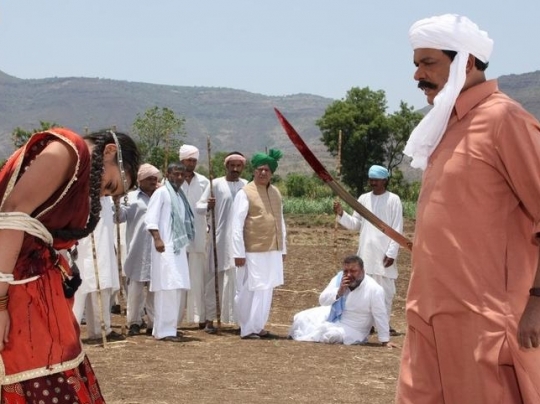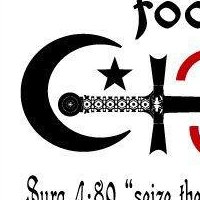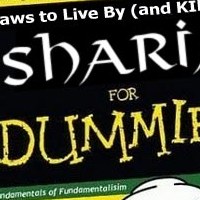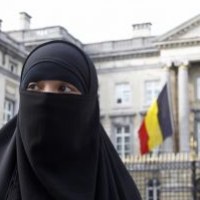![]()
Summer 2012 | The Middle East Quarterly, Volume XIX: Number 3, pp. 43-52 | by Phyllis Chesler and Nathan Bloom

Not even celebrity status can shield Muslim women from punishments related to honor crimes. Actress Afshan Azad (left), seen here with Harry Potter co-star Rupert Grint, was beaten and threatened with death in 2010 by her father and brother for dating a non-Muslim.
Although the overwhelming majority of honor killings worldwide occur within Muslim communities,[1] one would not know this by reading the mainstream media. Fearful of being labeled “Islamophobic,” the American press has given only glancing attention to the widespread, honor-related ritual murder of Muslim women in the Middle East and South Asia while treating periodic honor killings among Muslim immigrants in the West as ordinary domestic abuse cases.
Over the last few years, however, the media has published a flurry of articles about Hindu honor killings in India, the only non-Muslim-majority country where these murders are still rampant.[2] Apologists for Muslim culture and civilization rushed to herald the upsurge in Hindu (and Sikh) honor killings as evidence that the practice is “a universal problem, not an Islamic issue.”[3]
While India is indeed a striking exception to Islam’s near monopoly on contemporary honor killings, the following preliminary statistical survey shows Hindu honor killings in India to be different in form and commission from those of Muslims in neighboring Pakistan. Though no less gruesome, the Hindu honor killings seem largely confined to the north of India and are perpetuated by sociocultural factors largely specific to India. The millions of Indian Hindus who have immigrated to the West do not bring the practice along with them.
The recent spike of honor killings in India is likely the product of a clash between traditional and modern values, intensified by high economic growth and increasing social mobility. The spike may also reflect growing media coverage of this crime. The democratically elected government of India has taken important, if long overdue, steps to combat the practice of honor killing, and some progress has been made.
Not so in Pakistan where officials at all levels of government are either unable or unwilling to cope with honor killings. For Pakistan and many other Muslim countries, which have yet to experience the social stresses of rapid modernization or build the kind of political institutions that can eradicate a practice so deeply rooted in traditional beliefs — especially as Islamists now dominate — the worst may be yet to come.
The Social Milieu
Honor killing is the premeditated murder of a relative (usually a young woman) who has allegedly impugned the honor of her family. It tends to predominate in societies where individual rights are circumscribed by communal solidarities, patriarchal authority structures, and intolerant religious and tribal beliefs. Under such conditions, control over marriage and reproduction is critical to the socioeconomic status of kinship groups and the regulation of female behavior is integral to perceptions of honor, known as maryada in many Indian languages and as ghairat in Urdu and Pashto.

According to Hindu religious law and tradition, marrying or having sexual relations with a member of a different caste is strictly forbidden as is romantic involvement with someone from the same sub-caste. Local caste-based councils known as khap panchayats often prescribe punishments or even mandate the murder of those who violate their laws. The farmer seen here (right) sought police protection after the local khap vandalized his farmland for refusing to annul his son’s marriage to a “forbidden” woman. (Image via outlookindia.com)
In such an environment, a woman who refuses to enter into an arranged marriage, seeks a divorce, or fails to avoid suspicion of immoral behavior will be viewed by her family as having dishonored them so grievously that her male relatives will be ostracized and her siblings will have trouble finding suitable spouses. Killing her is the only way the family can restore its honor, regardless of whether she actually is or can be proven guilty of the alleged offense. In sharp contrast to other forms of domestic violence, honor killings are frequently performed out in the open, and the perpetrators rarely act alone. Unni Wikan, a social anthropologist and professor at the University of Oslo, observed that an honor killer typically commits the murder “as a commission from the extended family.”[4] The lead author of this article documented this in 2009[5] and 2010[6] for honor killings both in the West and in Muslim-majority countries.
Though neither Islam nor Hinduism directly sanctions honor killing, both play a role in legitimizing the practice in South Asia — if for no other reason than that such societies have not prosecuted this crime, have issued light sentences, or have failed to use their religious authority to punish and abolish it. Hindu society is divided into religiously mandated castes, membership in which is hereditary and effectively permanent. At the lowest rung of the ladder are roughly 150 million Indians who are called Dalits (the oppressed), commonly known in the West as “untouchables.” Although many Dalits have reached high political office, notably former president K. R. Narayanan,[7] they are still held in low regard by many other Indians.[8]
According to Hindu religious law and tradition, marrying or having sexual relations with a member of a different caste is strictly forbidden. So, too, is romantic involvement with someone from the same sub-caste (gotra),[9] a proscription that contrasts notably with Muslim cultures where first cousin marriage is widely accepted. The vast majority of Hindu honor killings target young Indians suspected of violating one of these two commandments. In northern India, the murders are often explicitly sanctioned or even mandated by caste-based councils known as khap panchayats.[10] Although the Hindu Marriage Act of 1955 made inter-caste and intra-gotra marriages legal, both remain unacceptable to the large majority of Indian Hindus. According to a 2006 survey, 76 percent of the Indian public oppose inter-caste marriage.[11] In some areas of the country, any marriage not arranged by the family is widely regarded as taboo. “Love marriages are dirty … only whores can choose their partners,” one council leader told an Indian reporter.[12]
Although Islam does not specifically endorse killing female family members, some honor killings involve allegations of adultery or apostasy, which are punishable by death under Shari’a (Islamic law). Thus, the belief that women who stray from the path can be rightly murdered is consistent with such Islamic teachings. The refusal of most Islamic authorities to unambiguously denounce the practice (as opposed to merely denying that Islam sanctions it) only encourages would-be honor killers.
While the Qur’an preaches the equality of all Muslims (or at least all Muslim males), and Islamic leaders frequently bemoan the evils of India’s caste system, vestiges of caste identification are evident among some Pakistani Muslims, who are descended from Hindus who were forcibly converted to Islam in the Middle Ages and were part of India before 1947.[13]
Empirical Trends
It is difficult to accurately estimate the number of honor killings that take place in Pakistan and India as the vast majority are believed to go unreported. In 2010, there were roughly 900 reported honor killings in the northern Indian states of Haryana, Punjab, and Uttar Pradesh alone while 100-300 additional honor killings took place in the rest of the country.[14] Also in 2010, according to the Human Rights Commission of Pakistan, 800 women were killed for honor in Pakistan.[15] Both figures likely represent only the tip of the iceberg. According to the Aurat Foundation, a Pakistani human rights organization: “At least 675 Pakistani women and girls were murdered during the first nine months of the calendar year 2011 for allegedly defaming their family’s honor.” Almost 77 percent of such honor cases ended in acquittals.[16] A similar study, published in 2011 by the Research and Development for Human Resources Women Rights Cell, found that 605 women and 115 men in Sindh were honor murdered or murdered in domestic disputes that same year.[17]
In order to compare and contrast honor killings in India and Pakistan, a sample was taken of 75 Hindu honor killings in India, including 50 cases that were specifically caste-based and 25 where the motive was not clearly specific to caste. The Indian cases were compared to 50 Muslim honor killings in Pakistan and 39 Pakistani Muslim honor killings in the West. Hindu honor killings in the West have been too rare to allow for valid statistical comparisons.[18] The researchers relied on English language media reports for data,[19] selecting the first cases that met the criteria of being a Hindu or Muslim honor killing and about which most of the following seven variables were known: location/religion; gender of victim; motive; the presence or absence of torture; age; number of victims per incident; and whether it was the woman’s or the man’s family who committed the killing.
The average age of all of the victims in this study, both male and female, was 22, with no statistically significant differences among the groups. Overwhelmingly, it was the women’s families that committed the honor killings even in cases in which there were male victims. In India, 94 percent of the killings were carried out by the woman’s family of origin. Four percent were killed jointly by both the man’s and the woman’s families of origin; in one case it was the allegedly shamed husband of a woman who did the killing; in no cases was it just the man’s family of origin. In Pakistan, the woman’s family of origin was responsible for 78 percent of the killings while husbands of “adulterous” wives accounted for another 16 percent. In 3 cases (6 percent) it was the man’s family of origin that committed the murder. The number of husbands who were killers was highest in Pakistan because a large percentage of the Pakistani victims (30 percent) had been accused of adultery. Among Pakistani Muslims in the West, 97 percent of the killings were by the woman’s family. This is to be expected, as it is women who are considered the keepers of male and family honor and responsibility to enforce society’s honor code falls on the women’s families.

In sharp contrast to other forms of domestic violence, honor killings are frequently performed out in the open; the perpetrators rarely act alone, and the murders are usually carried out by the woman’s family of origin. Canadians were shocked recently at the trial of the Shafia family, Muhammad and Tooba, who with the help of their son Hamed, drowned their three daughters along with Muhammad’s first wife in a canal near Kingston, Ontario. Top, from left: defendants Tooba Mohammad Yahya, Mohammad Shafia and Hamed Shafia. Bottom, from left: victims Sahar Shafia, 17; Zainab Shafia, 19; Geeti Shafia, 13; and Rona Amir Mohammad, 52. (Image via montrealgazette.com)
A number of statistically significant differences are notable.
Gender of Victims. In 40 percent of the cases, Indian Hindus murdered men while Pakistani Muslims murdered men only 14 percent of the time in Pakistan and 15 percent of the time in the West. The higher percentage of male victims in India underscores the fact that Hindu honor killings are more often about caste purity than sexual purity. While sexual purity is traditionally a female responsibility, the religious mandate to maintain strict boundaries between castes is an obligation for all Hindus, both male and female.
Motivation. The reported motivations underlying the killings varied significantly across the three groups. The researchers identified four major motives among Indian Hindus: caste-specific motives, “immoral character,” “contamination by association,” and non-caste-specific illicit relationships, which included interfaith relationships, adultery, pregnancy out of wedlock, and illicit relationships that were considered shameful for unspecified reasons. “Contamination by association” victims were killed not because they had done anything wrong but because of their association with the guilty party (mostly children of mothers who had been accused of violating sexual norms).
“Immoral character” victims were considered rebellious or licentious but were not suspected of being romantically involved with a specific individual. For example, Pakistani-Canadian Aqsa Parvez was lured to death by her mother and murdered by her father because she did not wear a hijab (head covering).[20] A 14-year-old Indian girl, S. Rajinilatha, was murdered by her father not because she was involved with any particular man but merely because she wrote love poetry.[21] Meena, an 18-year-old Hindu girl, was shot to death because she left her village for three days, and her family was not satisfied with her explanation of where she had been.[22]
In the case of Pakistani Muslims, the researchers identified three motives: illicit relationships, “contamination by association,” and “immoral character.” Only 4 percent of Muslim victims in Pakistan were killed because they were romantically involved with someone from a different caste, and caste was never a motive among Pakistani Muslims in the West. Consequently, the motive in this small number of cases was classified simply as “illicit relationship.”[23]
The reported motivations of Muslim honor killers in Pakistan differed from those of Pakistani Muslims in the West. In Pakistan, 12 percent of the victims were “immoral character” victims. In the West, 65 percent of the victims were “immoral character” victims. This may be because there are so many more opportunities for “immoral” assimilation/independence in the West, and young Pakistani women living there may be pushing boundaries more forcefully.
There were also significantly more “contamination by association” victims among Pakistani Muslims, both in Pakistan and in the West, than among the Hindus in India. For example, one Pakistani Muslim case in the West involved the murder of an adult sister-in-law, her young child, and a father-in-law who happened to be in the battered wife’s new home at the time. Only 4 percent of the Indian Hindus killed were “contamination by association” victims (n=3), compared to 22 percent of the Pakistani Muslim victims in Pakistan (n=11) and 19 percent of Pakistani Muslim victims in the West (n=7). The overwhelming majority of Hindu killings are caste-related, generally targeting young men and women shortly after they eloped and before they could have children. Pakistani Muslim honor killings are more often about obedience in general, especially sexual purity, and a woman’s sexual and moral purity can be challenged as long as she lives.
Torture. Some victims were killed in a manner clearly intended to maximize pain. For example, 17-year-old Anup Kumar of Haryana was electrocuted in 2011 for being in a relationship with a girl from the same sub-caste.[24] In Islamabad, 40-year-old Elahi Husain’s brothers tied her to a tree and stoned her to death in 2007 for being in a relationship of which they disapproved.[25]
The torture rate for Hindus in India (39 percent) was significantly higher than for Muslims in Pakistan (12 percent). Many of the Indian Hindu victims in this study were burned alive, electrocuted, or hacked to death. Even in cases where there was no torture, the bodies of the victims were often desecrated,[26] grimly displaying the family’s determination to restore its honor at all costs. It is possible that the torture rate in Pakistan is comparable to that in India and that Pakistani police and media are more circumspect in revealing gruesome details.
Among Pakistani Muslim victims in the West, however, a staggering 59 percent were tortured. Perhaps this is because the perpetrators feel so besieged and humiliated by the surrounding culture that they must take more extreme measures to reclaim their honor and because so many Pakistani girls and women are tempted to assimilate.
Pakistan’s Actions on Honor Killings
In Pakistan, the fusion of Islamic beliefs, a patriarchal social order, and tribal segmentation have effectively reduced women to the status of chattel. Pakistan was ranked 133 out of 135 countries in the World Economic Forum’s 2011 Global Gender Gap report.[27] A 2011 survey by the Thomson Reuters Foundation ranked Pakistan as the third most dangerous country in the world for women (India was fourth).[28]
According to Homa Arjomand, the Canadian lawyer who led the successful fight against the imposition of Shari’a law in Ontario, the lives of most girls and women in Pakistan are routinely terrible. They can expect that their husbands will rape and beat them savagely, often breaking their bones and knocking out their teeth; they may face extreme sadism during pregnancy as well as unhygienic and dangerous confinement as a permanent way of life; their families will not help them.[29]
The summary execution of female relatives for a wide range of suspected moral infractions is considered justifiable by many Pakistanis.[30] Tribal councils often sanction the practice[31] while local police turn a blind eye. Because of this impunity, honor killing is sometimes used as a pretext for other crimes. For example, according to Muhammad Haroon Bahlkani, an officer in the Community Development Department in Sindh, Pakistan, a “man can murder another man for unrelated reasons, kill one of his own female relatives, and then credibly blame his first victim for dishonoring the second. Or he can simply kill one of his female relatives, accuse someone rich of involvement with her, and extract financial compensation in exchange for forgoing vengeance.” Bahlkani has a name for this: the “Honor Killing Industry.”[32]
In Pakistan, many honor killings are known as karo-kari killings, which literally means “black male” and “black female” in Urdu and refers to cases in which adulterers are killed together. However, according to Bahlkani, there is an escape clause, but only for the men who can run away, hide, or pay restitution. Women are confined to the home, and few people will shelter a female runaway.
Although senior Pakistani officials have frequently denounced the practice of honor killing, little of substance has been achieved in combating it. While the penal code was stiffened in 2005 to impose a 10-year minimum sentence for honor killing,[33] legislative initiatives to protect women from domestic violence have been repeatedly watered down or abandoned in the face of Islamist opposition. In 2009, Pakistan’s National Assembly passed the Domestic Violence (Prevention and Protection) Bill, which strengthened legal protections against domestic violence for women and children. However, the Council of Islamic Ideology, a constitutional body charged with assessing whether laws are consistent with Islamic injunctions, issued a statement saying the bill “would fan unending family feuds and push up divorce rates.” After this, the bill was held up in the Pakistani senate and allowed to lapse. According to Special Public Prosecutor Nghat Dad, “The government’s attitude towards pushing for the cause has been hopeless ever since the Council of Islamic Ideology’s opposition.”[34]
Under Shari’a-based provisions of Pakistan’s judicial system, murderers can buy a pardon by paying blood money (dyad) to the victim’s family. Since the family of honor killing victims are nearly always sympathetic to the honor killer as well as complicit to some degree, getting a pardon is usually just a formality.[35] Women’s rights organizations in Pakistan have pressed parliament to disallow the practice of blood money in honor killing cases, but conservative Islamist groups have blocked the needed legislation.
Even when such arrangements do not take place, honor killers are rarely prosecuted for lack of cooperative witness testimony. For those few who happen to be convicted, a light prison sentence is far preferable to dishonor. According to the Human Rights Commission of Pakistan in a recent report: “The legal, preventative, and protective measures needed to provide effective protection to women against violence perpetrated in the name of honor remained absent.”[36]
India’s Actions on Honor Killings
Indian society at large is no less misogynistic than that of Pakistan. Since boys are preferred and girls are seen as a burden, an estimated four to twelve million selective abortions of girls have occurred in India in the past three decades.[37] The 2011 Indian census found 914 girls for every 1,000 boys among children six or younger.[38] Dowry burnings, the practice of a man and his mother dousing his wife with cooking oil and burning her alive so that a new bride and dowry can be obtained, are as big a problem as honor killings in India.[39]
As the Indian media have fastidiously documented,[40] there has been a marked increase in the number of reported honor killings in recent years. In 2010, a government-funded study on the prevalence of honor crimes in India found that they are most common in regions dominated by khap panchayats and increasingly involve inter-caste, rather than intra-sub-caste marriages.[41] In these regions, local politicians turn a blind eye to the murders and resist efforts by the central government and parliament to deal with the problem while local police collude in honor killings[42] or help cover them up, often mischaracterizing the murders as suicides.[43] In 2011, theaters in Haryana refused to screen an Indian film on honor killings because of threats by khap panchayats.[44]

In India, honor murders are frequently sanctioned by castebased councils known as khap panchayats. Filmmakers in India have sought to highlight the horrors of Hindu honor killings, such as this one portrayed in a film. But theaters in the northern province of Haryana refused to screen this film in 2011 and issued threats against those who would show the movie. (Image via reuters.com)
According to Prem Chowdhry of the Delhi School of Economics, honor killings were less frequent in the past “because elopements didn’t happen … livelihood was so clearly tied to the land, and the land was so clearly enmeshed in these relationships.”[45] Greater socioeconomic mobility has weakened these bonds. As khap panchayats struggle against modernization, preserving their traditional power means retaining control over reproduction, and they have resorted to violence to achieve this.
In sharp contrast to their Pakistani counterparts, Indian government officials have vigorously condemned honor killings in their country.[46] So, too, have liberal Indian media outlets,[47] some of which have done aggressive investigative reporting on the issue. In 2010, an undercover reporter working for the Indian television channel Headlines Today found two policemen from the northern state of Haryana who boasted about their willingness to hand over a young woman to be honor murdered. “Cut her into pieces and then throw her in some river,” one said.[48] A number of Indian nongovernmental organizations are working to defend women from honor killings. The Love Commandos, with 2,000 volunteers and a 24-hour national hotline, are devoted to protecting newlyweds who defy their families.[49]
In 2010, Prime Minister Manmohan Singh ordered a cabinet-level commission to draft national legislation designed to eradicate honor killing.[50] The proposals included an amendment to the penal code allowing khap panchayats leaders to be prosecuted for sanctioning murders as well as the revocation of the 30-day notice period required by the Special Marriage Act, which has enabled families to track down and preemptively kill the couples.[51] In 2011, the Law Commission of India, under the Ministry of Law and Justice, drafted a new bill — The Endangerment of Life and Liberty (Protection, Prosecution and Other Measures) Act — designed to prevent khap panchayats from denouncing couples who violate caste restrictions. According to the bill,
It shall be unlawful for any group of persons to gather, assemble or congregate with the … intention to deliberate, declare on, or condemn any marriage or relationship such as marriage between two persons of majority age in the locality concerned on the basis that such conduct or relationship has dishonored the caste or community or religion of all or some of the persons forming part of the assembly or the family or the people of the locality concerned.[52]
The fate of this legislation is uncertain, however, as the khap panchayats‘ control over local voting blocs has enabled them to blunt legislative reforms in the past. The government has made more progress on the judicial front. In 2010, India’s Supreme Court instructed the governments in Haryana and six other states to take steps to protect potential honor killing victims.[53] In 2011, it decried honor killing as a “barbaric and shameful” practice that must be “ruthlessly stamped out.”[54] The court also declared honor killings ordered by khap panchayats to be illegal and warned that government officials who fail to act against honor crime offenders will be prosecuted.[55]
Although fear of caste ostracism makes it difficult to find cooperative witnesses, Indian courts have begun aggressively prosecuting honor killers and their accomplices. In 2010, a Haryana court sentenced five men to death for the honor murder of a young couple who had married despite being members of the same sub-caste while giving a life sentence to the head of the khap panchayat that ordered their deaths.[56] In November 2011, an Indian court sentenced eight men to death and twenty others to life imprisonment for involvement in three honor killings.[57] Increasingly, local police officials have been suspended and even arrested for collusion in honor killings.[58]
India still has a long way to go. While the Indian government continues to face resistance and evasion of responsibility on the part of local officials, it has not encountered the same kind of virulent, often violent, opposition to women’s rights typical of Pakistani Islamists. There is little doubt that India is determined to win what promises to be a long battle against honor killing. The Western media’s interest in Hindu honor killings developed only after Indians themselves began exposing the practice and pressing for change.
Conclusion
Although Hindu honor killing is a gruesome and sordid affair, it differs in many important respects from honor killing in neighboring Pakistan and other Muslim countries. Indian Hindus murder men for honor more often than do Pakistani Muslims, and they murder for reasons mainly related to concerns about caste purity.
Perhaps the most striking characteristic of Hindu honor killings is the fact that Indians abandon the horrific practice when they migrate to the West whereas many Pakistani Muslims carry it with them. Part of the explanation may lie in their different patterns of acculturation upon immigrating to the West. Young Hindus in the West are no less prone to violate traditional social codes than young Muslims, and their parents may be no less furious when they do, but Hindu families in the West do not feel the same degree of public humiliation and shame as they might experience back in India. They are eager to preserve their cultural identity but not at the expense of alienating their adoptive communities. The absence of dreaded khap panchayats no doubt mitigates the consequences of dishonor.
Due in part to the spread of radical Islamist ideology, Muslim immigrants in the West are either radicalized or socialize predominantly within Muslim-only communities, and their conception of honor reflects this. Even affluent young women of Pakistani descent in the West can face the credible threat of death or severe bodily harm. Actress Afshan Azad, who played Padma Patil in the Harry Potter film series, was beaten and threatened with death in 2010 by her Pakistani father and brother for dating a non-Muslim.[59] If she can be victimized, anyone can.
While it is alarming that there are so many honor killings in India and Pakistan, there may yet be cause for hope. Every honor killing begins with a rebellion against tribalism and patriarchy — or with a fear that tribal and patriarchal values are under attack. Many of the victims in our study were people who believed that they could push traditional boundaries, that they could get away with asserting their rights. They were wrong, and they paid the ultimate price for that mistake, but the key is that they tried. More rebels will follow.
Phyllis Chesler is emerita professor of psychology and women’s studies at the Richmond College of the City University of New York, author of fourteen books, and co-founder of the Association for Women in Psychology and the National Women’s Health Network.
Nathan Bloom, a recent graduate of the University of Chicago, is a former assistant to Phyllis Chesler. The authors thank Tchia and Avraham Snapiri of IDEA-Management and Economic Consulting Ltd., for performing the statistical tests for this study, and Petra Bailey for help in gathering the data.
![]()
Notes:
[1] Phyllis Chesler, “Worldwide Trends in Honor Killings,” Middle East Quarterly, Spring 2010, pp. 3-11.
[2] For example, see The New York Times, July 9, 2010, June 4, 2011; The Washington Post, Nov. 22, 2008.
[3] John L. Esposito, “Honor Killing: Is Violence against Women a Universal Problem, Not an Islamic Issue?” The Huffington Post, Sept. 4, 2010.
[4] Unni Wikan, “The Honor Culture,” Karl-Olov Arnstberg and Phil Holmes, trans., originally published as En Fraga Om Hedre, Cajsa Mitchell, trans. (Stockholm: Ordfront Forlag AB, 2005).
[5] Phyllis Chesler, “Are Honor Killings Simply Domestic Violence?” Middle East Quarterly, Spring 2009, pp. 61-9.
[6] Chesler, “Worldwide Trends in Honor Killings,” pp. 3-11.
[7] The New York Times, July 26, 1997.
[8] “Caste-based Discrimination in South Asia,” European Commission (Brussels) and the International Dalit Solidarity Network, June 2009; “Broken People: Caste Violence against India’s ‘Untouchables,'” Human Rights Watch, Washington, D.C., Apr. 1, 1999.
[9] The Australian (Sydney), Apr. 3, 2010.
[10] Times of India (Mumbai), Mar. 30, 2010.
[11] The New York Times, July 9, 2010.
[12] Times of India, Sept. 8, 2009.
[13] See Yoginder Sikand, “Islam and Caste Inequality among Indian Muslims,” Asianists’ Asia, first published in Qalandar (Paris), T. Wignesan, ed., Mar. 2004; Anatol Lieven, Pakistan. A Hard Country(New York: Public Affairs, 2011), pp. 101-2.
[14] The Hindu (Chennai, Madras), July 11, 2010.
[15] Dawn (Karachi), Aug. 9, 2011.
[16] Business Reporter (Karachi), Jan. 5, 2012.
[17] Ibid., Jan. 9, 2012.
[18] Chesler, “Worldwide Trends in Honor Killings,” pp. 3-11.
[19] For Indian Hindu cases: The Times of India, The Hindustan Times (New Delhi), Press Trust of India News Service (Delhi), The Independent (London), The Washington Post, Reuters, The Hindu, Indian Express (Chennai, Madras), Outlook India (New Delhi), Thaindian News (Bangkok), Indo-Asian News Service (New Delhi), and the BBC. For Pakistani cases: Associated Press, The Pakistan Daily Times(Lahore), stophonourkillings.com, The Daily Telegraph (London), The News International (Karachi, Lahore and Rawalpindi/Islamabad), The Regional Times of Sindh (Hyderabad and Karachi), Dawn, andPakistan Today (Lahore). The Indian honor killings took place between 2001 and 2011; those in Pakistan between 1999 and 2011. The Pakistani honor killings in the West took place between 1998 and 2009.
[20] The National Post (Toronto), Dec. 12, 2007.
[21] “‘Honour’ Killings on the Rise in Tamil Nadu,” Stop Honour Killings, London, Sept. 16, 2010.
[22] Times of India, Feb. 16, 2011; Mid-Day (Mumbai and Delhi), Feb. 15, 2011.
[23] See Sikand, “Islam and Caste Inequality among Indian Muslims.”
[24] Times of India, Jan. 28, 2011.
[25] The Daily Telegraph, Jan. 31, 2007.
[26] Reuters, May 16, 2008; The Economist, Apr. 15, 2010.
[27] The Global Gender Gap Report 2011, The World Economic Forum, Geneva, Nov. 2011.
[28] “The World’s Most Dangerous Countries for Women,” Thomson Reuters Foundation, New York, June 15, 2011.
[29] Homa Arjomand, “Effect of globalization of political Islam on women,” www.nosharia.com, accessed Mar. 28, 2012.
[30] See, for example, Asian Human Rights Commission, Hong Kong, May 12, 2011; The China Post(Taipei), Mar. 10, 2012; BBC Urdu, Aug. 29, 2008.
[31] Lieven, Pakistan, pp. 101-2.
[32] Correspondence with Muhammad Haroon Bahlkani, 2010, 2011.
[33] USA Today, Dec. 28, 2005.
[34] Iffat Gill, “Can legal reforms protect women in Pakistan?” Worldpulse.com, Portland, Ore., Mar. 29, 2011.
[35] BBC, Mar. 2, 2005.
[36] “State of Human Rights in 2010,” Human Rights Commission of Pakistan, Lahore, Apr. 2011, p. 206.
[37] Prabhat Jha, et al., “Trends in selective abortions of girls in India: analysis of nationally representative birth histories from 1990 to 2005 and census data from 1991 to 2011,” The Lancet, May 24, 2011, pp. 1921-8.
[38] The New York Times, May 24, 2011.
[39] BBC, July 16, 2003.
[40] The New York Times, July 9, 2010.
[41] The Tribune (Chandigarh, India), May 14, 2011.
[42] “India: Prosecute Rampant ‘Honor’ Killings: Amend and Enforce Laws to End Barbaric Practice,” Human Rights Watch, New York, July 18, 2010.
[43] See, for example, Times of India, Mar. 15, 2011.
[44] Indian Express, July 30, 2011.
[45] The Australian, Apr. 23, 2010.
[46] See, for example, Times of India, Aug. 1, 2010.
[47] “Barbarian Face,” ibid., July 4, 2007.
[48] India Today (New Delhi), Sept. 17, 2010.
[49] The Guardian (London), Oct. 10, 2010.
[50] Times of India, July 9, 2010.
[51] “India: Prosecute Rampant ‘Honor’ Killings,” July 18, 2010.
[52] The Hindu, June 8, 2011.
[53] Times of India, June 21, 2010.
[54] BBC, Apr. 20, 2011.
[55] “Crime and Punishment,” Times of India, Apr. 27, 2011.
[56] The Australian, Apr. 3, 2010.
[57] International Business Times (New York), Nov. 16, 2011.
[58] The Australian, Apr. 3, 2010.
[59] The Telegraph, Dec. 20, 2010.



 RSS
RSS










Latest Comments
Hello Mike, Thank you for your positive feedback to the article. I felt there wasn’t too much critical analysis of ...
Thanks for this considered and well constructed article. A follow up article on the manner in which the editorial contro...
THE CLUELESSNESS OF CLAIMING THAT OBAMA'S MIDDLE EAST POLICIES WERE A FAILURE CANNOT BE FURTHER FROM THE TRUTH, WHAT THE...
As long as Obama is the president of the usa do not trust the us government......
Thank you for an good read....